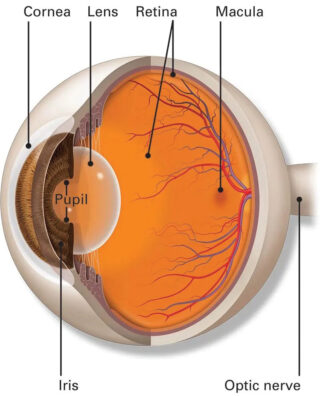
More Vision & Eye Care Articles
Laser-Assisted Surgeries

Laser vision corrective surgeries have made great strides in the past 30 years. The use of lasers in LASIK and cataract surgeries not only improves the patient’s refractive outcomes but is also easier and safer in the long-term.
Refractive Errors
There are three main components of refraction (bending of light) in the eye: the cornea, the lens, and the retina.
For normal vision, light passes through the cornea and lens and hits the retina. Refractive errors occur when the eye does not refract (or bend) light properly due to the shape of the cornea. This can prevent light from traveling through the lens and landing on the retina. These errors are known as myopia (nearsightedness), hyperopia (farsightedness) and astigmatism. Laser correction surgeries, such as LASIK and Epi-LASIK, improve these conditions by reshaping the cornea.
LASIK and Epi-LASIK
LASIK and Epi-LASIK are ideal procedures for those looking to correct refractive errors and eliminate or minimize the need for glasses or contact lenses.
The main difference in LASIK and Epi-LASIK is the creation of a flap. During LASIK a flap is created and in Epi-LASIK only the surface epithelium is removed before application of the Laser.
Refractive outcomes are comparable for both procedures, but Epi-LASIK is a safer procedure and ideal for patients with thinner corneas. The flapless Epi-LASIK procedure may cause more discomfort in the first couple days of healing but runs less risk of long term complications.
Laser-Assisted Cataract Surgery
Majority of people will develop cataracts within their lifetime. Cataracts are a clouding of the lens of the eye that can cause blurry vision. Cataract surgery removes the clouded lens and implants an artificial lens. While this procedure removes the blurriness, refractive errors due to the shape of the cornea are not corrected without laser assistance.
Femtosecond Laser-assisted cataract surgery (FLACS) has all of the benefits of standard cataract surgery, but it is safer and offers additional vision correction. Traditional cataract surgery requires the surgeon to manually make incisions in the side of the cornea to extract to cataract. When using a laser, the incision is more precise, and the laser softens the cataract before the surgeon removes it from the eye. The recovery after Laser cataract surgery is much faster than the traditional ultrasonic surgery and the rate of complications is lower for laser-assisted cataract surgery.
Other Articles You May Find of Interest...
- Dry Eye Relief Is In Sight With Optilight
- iDesign Advanced WaveScan Studio
- Norcross Vision Innovators: Glaucoma and Cataract Solutions
- Exploring the Benefits Of Intense Pulsed Light (IPL) For Ocular Surface Health
- Lose Years Off Your Face In Just One Hour
- How to Find a Great Online Shop Offering Same Day Glasses Shipping: Your Quick Guide
- March Is Workplace Eye Wellness Month

















